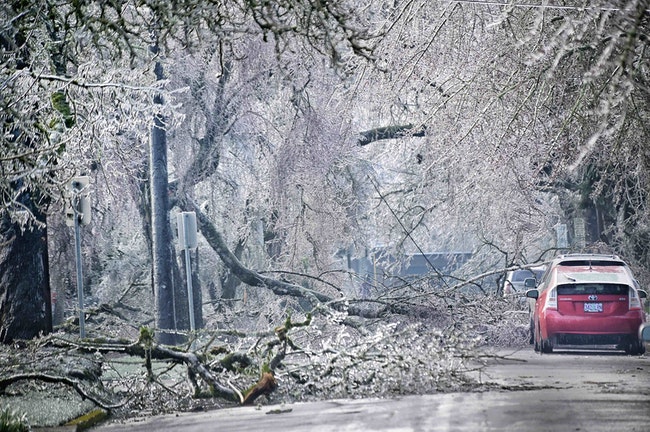
Streets around Salem were impassible in the days following the February 2021 ice storm due to downed trees and debris. (Ron Cooper/Salem Reporter)
Last year was rough for trees in Salem, with significant losses from the February 2021 ice storm and additional stress caused by drought and the extreme heat wave in late June.
A report recently published by the city’s public works department and presented to the city council gives an accounting of the damage: more than 1,000 trees damaged in the ice storm removed in 2021, and roughly 1,061 acres of tree canopy lost.
A satellite image analysis of the city’s tree canopy in May 2021 showed about 17.6% of it was lost compared to the latest survey in August 2020.
“We did lose a significant chunk of our urban canopy,” said Patricia Farrell, Salem’s parks and natural resources planning manager, presenting the report during a March 28 city council meeting.
But Salem remains on track to meet a long-term goal of increasing the percentage of the city covered by trees thanks to new growth and planting, which added about 843 new acres to the city’s tree canopy.
That means the net 2021 losses were about 219 acres of tree canopy, or 3.6% of 2020’s cover.
“Camera angle, seasonal variation in canopy, and pruning or tree removals for other reasons likely account for some portion of this observed change; therefore, it is not possible to quantitatively discern the exact amount of damage incurred as a direct result of the ice storm. It is clear however that a large percentage of the 1,000+ acres of canopy loss is attributable to the ice storm,” the report read.
Another 10 acres were lost to development in 2021.
Salem forestry workers typically assess the city’s tree canopy once per decade and last did a complete survey in 2019, finding 24% of the city was covered by tree canopy. The city council in 2020 set a goal to increase that number to 28% by 2030.
Public works department leaders opted to assess the canopy again using aerial images following the ice storm because of the scale of the damage.
The results are viewable on an interactive map, which allows people to see the amount of tree acreage lost and gained by city council ward and city park.
“We’re hoping that we’re not going to fall too short of our goal even with the loss given the number of trees that we’re planting and protecting now,” Farrell said.
Responding to the ice storm’s damage consumed much of the year for urban forestry workers, and the city brought in more contracted companies to help with cleaning up debris from trees. The city spent $6.3 million on ice storm cleanup, which continued into the summer.
Overall in 2021, city employees and contractors removed 1,218 trees around Salem. Over 1,000 of them were removed due to ice storm damage, the report said.
Much of the recorded damage was in the city’s parks, particularly Minto Brown Island Park, which saw 57.6 acres of canopy lost in 2021, and 56 gained due to growth and new planting, according to the map.
Workers and volunteers planted a total of 425 new trees citywide in 2021, including 147 by city staff, 183 by contractor Friends of Trees, which runs volunteer planting events, and 92 by contractor Treecology.
Friends of Trees also planted more than 2,000 shrubs and container trees citywide.
The city report also includes results from a survey of Salem residents focused on people living in areas with low tree cover – particularly wards 5 and 6, northeast and east Salem, which have the smallest tree canopies in the city.
Overall, the survey found few people living in low-tree areas knew about the city’s efforts to increase tree cover, with six in 10 reporting they were somewhat or very unfamiliar with city goals and programs to grow the tree cover. Despite that, seven in 10 said they would like more trees in their neighborhood, and 56% said they would like more on their property.
Two-thirds of those living in low tree cover areas said free or low cost trees would make them more likely to plant a tree, and about the same share said information on where to plant and what type of tree.
The responses were overwhelmingly from people who own their properties, not renters, and those who responded were more likely to be white than the city as a whole.
Farrell said the city will continue outreach to let people know about tree programs and identify ways to increase tree cover in areas where it’s lacking.
Contact reporter Rachel Alexander: [email protected] or 503-575-1241.
JUST THE FACTS, FOR SALEM – We report on your community with care and depth, fairness and accuracy. Get local news that matters to you. Subscribe to Salem Reporter starting at $5 a month. Click I want to subscribe!









